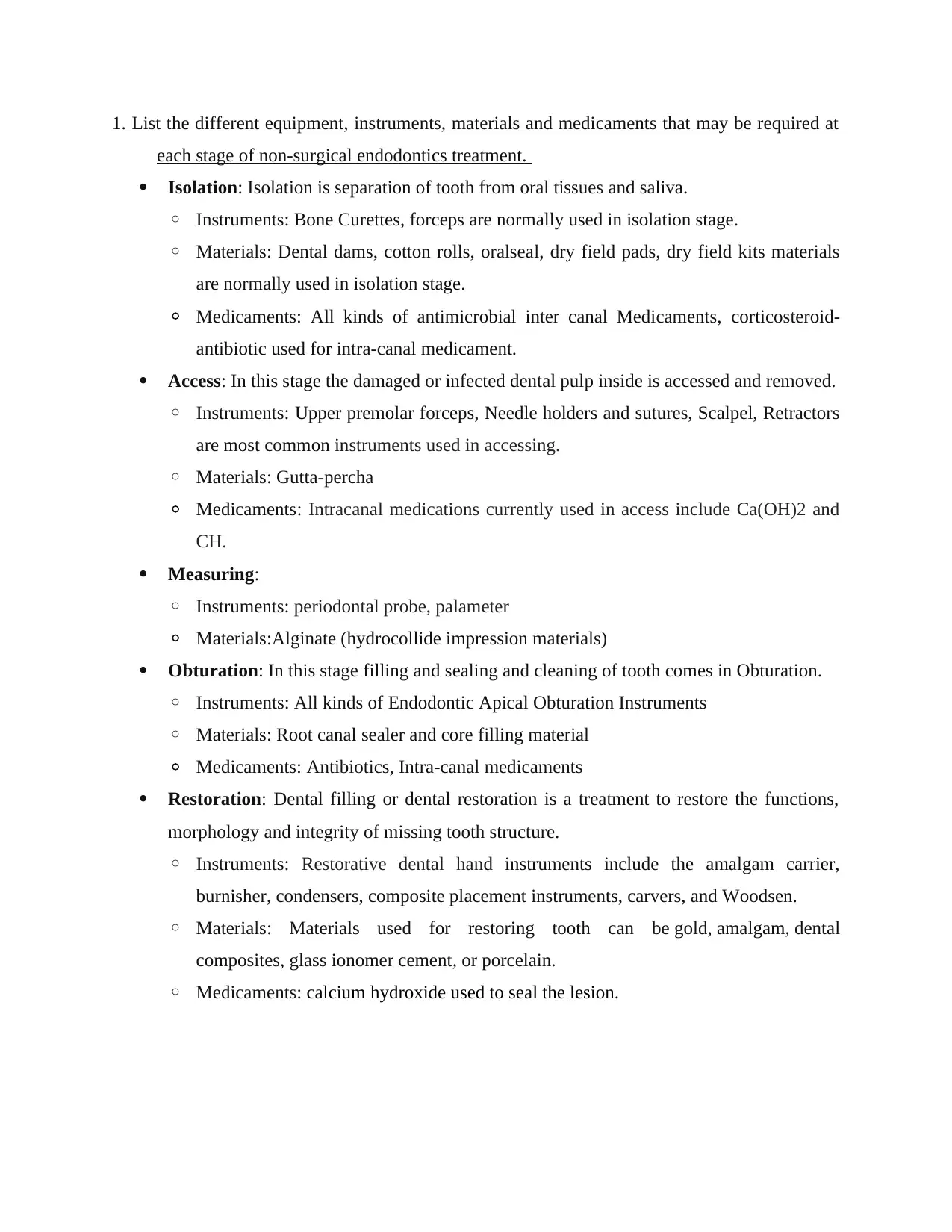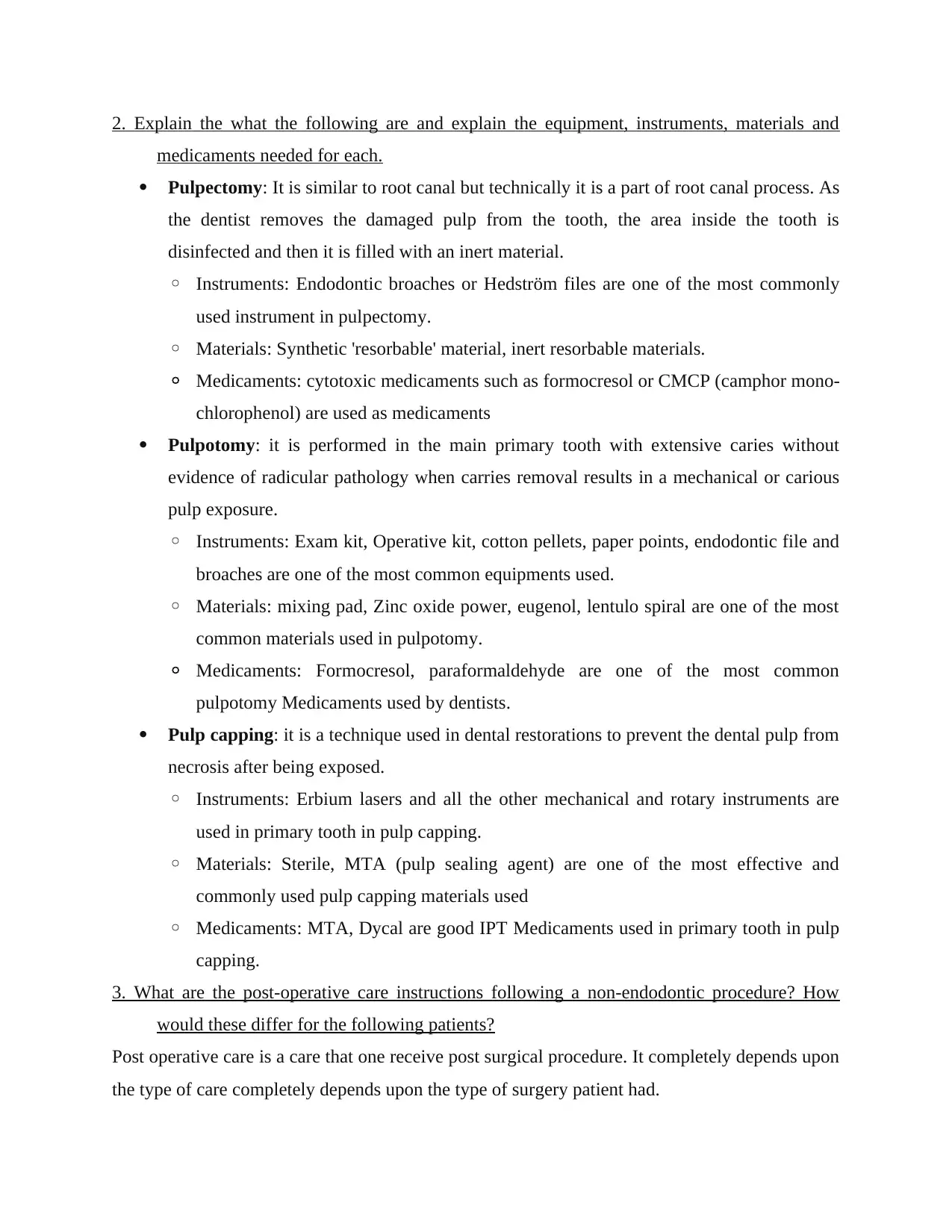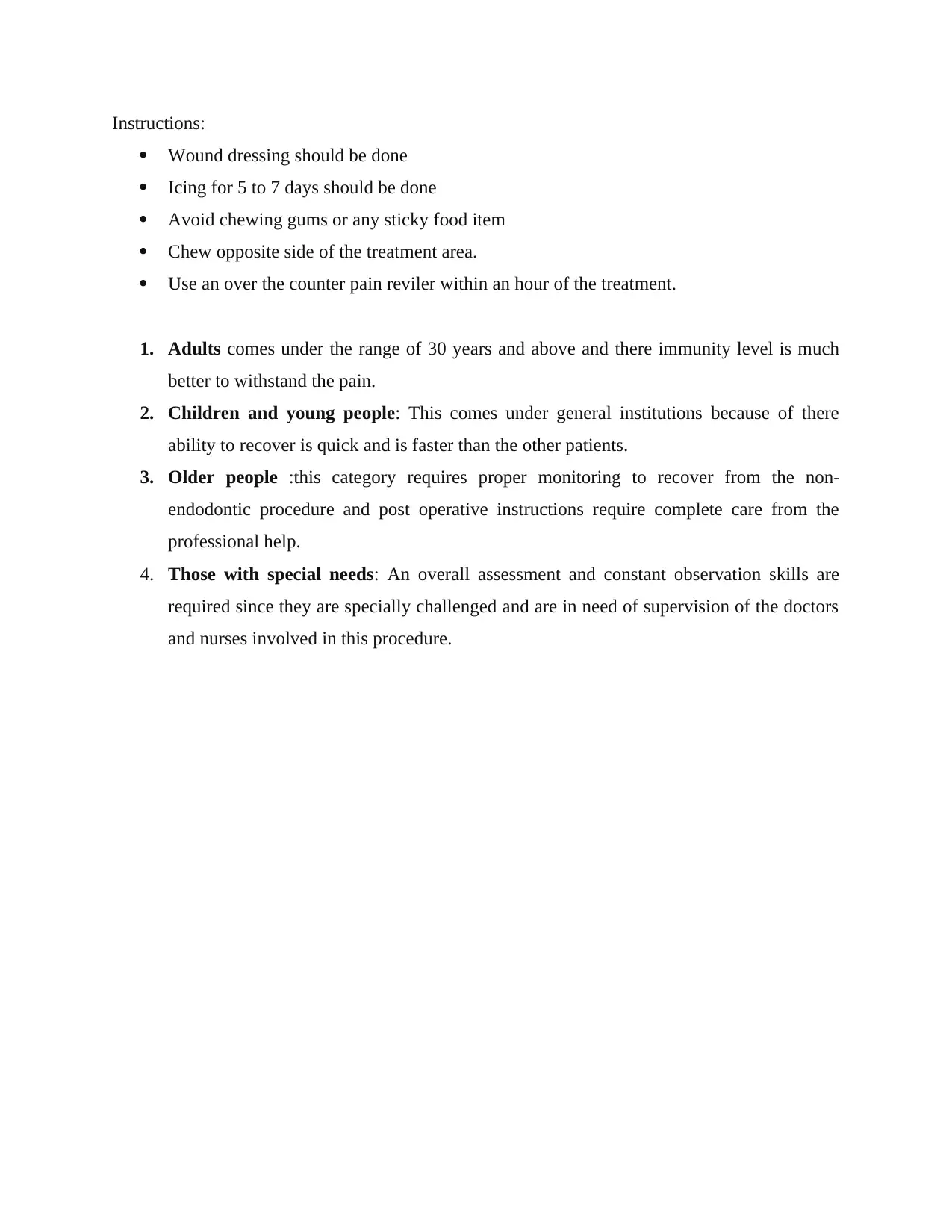Dental Materials assignment
VerifiedAdded on 2021/01/02
|4
|795
|274
AI Summary
Contribute Materials
Your contribution can guide someone’s learning journey. Share your
documents today.

DENTAL-10
Secure Best Marks with AI Grader
Need help grading? Try our AI Grader for instant feedback on your assignments.

1. List the different equipment, instruments, materials and medicaments that may be required at
each stage of non-surgical endodontics treatment.
Isolation: Isolation is separation of tooth from oral tissues and saliva.
◦ Instruments: Bone Curettes, forceps are normally used in isolation stage.
◦ Materials: Dental dams, cotton rolls, oralseal, dry field pads, dry field kits materials
are normally used in isolation stage.
◦ Medicaments: All kinds of antimicrobial inter canal Medicaments, corticosteroid-
antibiotic used for intra-canal medicament.
Access: In this stage the damaged or infected dental pulp inside is accessed and removed.
◦ Instruments: Upper premolar forceps, Needle holders and sutures, Scalpel, Retractors
are most common instruments used in accessing.
◦ Materials: Gutta-percha
◦ Medicaments: Intracanal medications currently used in access include Ca(OH)2 and
CH.
Measuring:
◦ Instruments: periodontal probe, palameter
◦ Materials:Alginate (hydrocollide impression materials)
Obturation: In this stage filling and sealing and cleaning of tooth comes in Obturation.
◦ Instruments: All kinds of Endodontic Apical Obturation Instruments
◦ Materials: Root canal sealer and core filling material
◦ Medicaments: Antibiotics, Intra-canal medicaments
Restoration: Dental filling or dental restoration is a treatment to restore the functions,
morphology and integrity of missing tooth structure.
◦ Instruments: Restorative dental hand instruments include the amalgam carrier,
burnisher, condensers, composite placement instruments, carvers, and Woodsen.
◦ Materials: Materials used for restoring tooth can be gold, amalgam, dental
composites, glass ionomer cement, or porcelain.
◦ Medicaments: calcium hydroxide used to seal the lesion.
each stage of non-surgical endodontics treatment.
Isolation: Isolation is separation of tooth from oral tissues and saliva.
◦ Instruments: Bone Curettes, forceps are normally used in isolation stage.
◦ Materials: Dental dams, cotton rolls, oralseal, dry field pads, dry field kits materials
are normally used in isolation stage.
◦ Medicaments: All kinds of antimicrobial inter canal Medicaments, corticosteroid-
antibiotic used for intra-canal medicament.
Access: In this stage the damaged or infected dental pulp inside is accessed and removed.
◦ Instruments: Upper premolar forceps, Needle holders and sutures, Scalpel, Retractors
are most common instruments used in accessing.
◦ Materials: Gutta-percha
◦ Medicaments: Intracanal medications currently used in access include Ca(OH)2 and
CH.
Measuring:
◦ Instruments: periodontal probe, palameter
◦ Materials:Alginate (hydrocollide impression materials)
Obturation: In this stage filling and sealing and cleaning of tooth comes in Obturation.
◦ Instruments: All kinds of Endodontic Apical Obturation Instruments
◦ Materials: Root canal sealer and core filling material
◦ Medicaments: Antibiotics, Intra-canal medicaments
Restoration: Dental filling or dental restoration is a treatment to restore the functions,
morphology and integrity of missing tooth structure.
◦ Instruments: Restorative dental hand instruments include the amalgam carrier,
burnisher, condensers, composite placement instruments, carvers, and Woodsen.
◦ Materials: Materials used for restoring tooth can be gold, amalgam, dental
composites, glass ionomer cement, or porcelain.
◦ Medicaments: calcium hydroxide used to seal the lesion.

2. Explain the what the following are and explain the equipment, instruments, materials and
medicaments needed for each.
Pulpectomy: It is similar to root canal but technically it is a part of root canal process. As
the dentist removes the damaged pulp from the tooth, the area inside the tooth is
disinfected and then it is filled with an inert material.
◦ Instruments: Endodontic broaches or Hedström files are one of the most commonly
used instrument in pulpectomy.
◦ Materials: Synthetic 'resorbable' material, inert resorbable materials.
◦ Medicaments: cytotoxic medicaments such as formocresol or CMCP (camphor mono-
chlorophenol) are used as medicaments
Pulpotomy: it is performed in the main primary tooth with extensive caries without
evidence of radicular pathology when carries removal results in a mechanical or carious
pulp exposure.
◦ Instruments: Exam kit, Operative kit, cotton pellets, paper points, endodontic file and
broaches are one of the most common equipments used.
◦ Materials: mixing pad, Zinc oxide power, eugenol, lentulo spiral are one of the most
common materials used in pulpotomy.
◦ Medicaments: Formocresol, paraformaldehyde are one of the most common
pulpotomy Medicaments used by dentists.
Pulp capping: it is a technique used in dental restorations to prevent the dental pulp from
necrosis after being exposed.
◦ Instruments: Erbium lasers and all the other mechanical and rotary instruments are
used in primary tooth in pulp capping.
◦ Materials: Sterile, MTA (pulp sealing agent) are one of the most effective and
commonly used pulp capping materials used
◦ Medicaments: MTA, Dycal are good IPT Medicaments used in primary tooth in pulp
capping.
3. What are the post-operative care instructions following a non-endodontic procedure? How
would these differ for the following patients?
Post operative care is a care that one receive post surgical procedure. It completely depends upon
the type of care completely depends upon the type of surgery patient had.
medicaments needed for each.
Pulpectomy: It is similar to root canal but technically it is a part of root canal process. As
the dentist removes the damaged pulp from the tooth, the area inside the tooth is
disinfected and then it is filled with an inert material.
◦ Instruments: Endodontic broaches or Hedström files are one of the most commonly
used instrument in pulpectomy.
◦ Materials: Synthetic 'resorbable' material, inert resorbable materials.
◦ Medicaments: cytotoxic medicaments such as formocresol or CMCP (camphor mono-
chlorophenol) are used as medicaments
Pulpotomy: it is performed in the main primary tooth with extensive caries without
evidence of radicular pathology when carries removal results in a mechanical or carious
pulp exposure.
◦ Instruments: Exam kit, Operative kit, cotton pellets, paper points, endodontic file and
broaches are one of the most common equipments used.
◦ Materials: mixing pad, Zinc oxide power, eugenol, lentulo spiral are one of the most
common materials used in pulpotomy.
◦ Medicaments: Formocresol, paraformaldehyde are one of the most common
pulpotomy Medicaments used by dentists.
Pulp capping: it is a technique used in dental restorations to prevent the dental pulp from
necrosis after being exposed.
◦ Instruments: Erbium lasers and all the other mechanical and rotary instruments are
used in primary tooth in pulp capping.
◦ Materials: Sterile, MTA (pulp sealing agent) are one of the most effective and
commonly used pulp capping materials used
◦ Medicaments: MTA, Dycal are good IPT Medicaments used in primary tooth in pulp
capping.
3. What are the post-operative care instructions following a non-endodontic procedure? How
would these differ for the following patients?
Post operative care is a care that one receive post surgical procedure. It completely depends upon
the type of care completely depends upon the type of surgery patient had.

Instructions:
Wound dressing should be done
Icing for 5 to 7 days should be done
Avoid chewing gums or any sticky food item
Chew opposite side of the treatment area.
Use an over the counter pain reviler within an hour of the treatment.
1. Adults comes under the range of 30 years and above and there immunity level is much
better to withstand the pain.
2. Children and young people: This comes under general institutions because of there
ability to recover is quick and is faster than the other patients.
3. Older people :this category requires proper monitoring to recover from the non-
endodontic procedure and post operative instructions require complete care from the
professional help.
4. Those with special needs: An overall assessment and constant observation skills are
required since they are specially challenged and are in need of supervision of the doctors
and nurses involved in this procedure.
Wound dressing should be done
Icing for 5 to 7 days should be done
Avoid chewing gums or any sticky food item
Chew opposite side of the treatment area.
Use an over the counter pain reviler within an hour of the treatment.
1. Adults comes under the range of 30 years and above and there immunity level is much
better to withstand the pain.
2. Children and young people: This comes under general institutions because of there
ability to recover is quick and is faster than the other patients.
3. Older people :this category requires proper monitoring to recover from the non-
endodontic procedure and post operative instructions require complete care from the
professional help.
4. Those with special needs: An overall assessment and constant observation skills are
required since they are specially challenged and are in need of supervision of the doctors
and nurses involved in this procedure.
1 out of 4
Your All-in-One AI-Powered Toolkit for Academic Success.
+13062052269
info@desklib.com
Available 24*7 on WhatsApp / Email
![[object Object]](/_next/static/media/star-bottom.7253800d.svg)
Unlock your academic potential
© 2024 | Zucol Services PVT LTD | All rights reserved.


